预约演示
更新于:2025-08-29

Sichuan Kelun Pharmaceutical Co., Ltd.
更新于:2025-08-29
概览
标签
肿瘤
神经系统疾病
消化系统疾病
小分子化药
化学药
ADC
疾病领域得分
一眼洞穿机构专注的疾病领域
暂无数据
技术平台
公司药物应用最多的技术
暂无数据
靶点
公司最常开发的靶点
暂无数据
| 排名前五的药物类型 | 数量 |
|---|---|
| 小分子化药 | 28 |
| ADC | 13 |
| 单克隆抗体 | 9 |
| 化学药 | 8 |
| 核素偶联药物 | 3 |
关联
66
项与 四川科伦药业股份有限公司 相关的药物靶点 |
作用机制 PDL1抑制剂 |
在研机构 |
原研机构 |
最高研发阶段批准上市 |
首次获批国家/地区 中国 |
首次获批日期2024-12-25 |
作用机制 TOP1抑制剂 [+1] |
在研机构 |
原研机构 |
在研适应症 |
非在研适应症- |
最高研发阶段批准上市 |
首次获批国家/地区 中国 |
首次获批日期2024-11-22 |
作用机制 5-HT1A receptor激动剂 [+2] |
在研机构 |
最高研发阶段批准上市 |
首次获批国家/地区 美国 |
首次获批日期2015-07-10 |
281
项与 四川科伦药业股份有限公司 相关的临床试验NCT07087197
A Multicenter, Open-label Phase I Clinical Trial to Evaluate the Safety, Tolerability, Pharmacokinetics, Dosimetry and Efficacy of SKB107 in Subjects With Advanced Solid Tumors With Bone Metastases
A multicenter, open-label Phase I clinical trial to evaluate the safety, tolerability, pharmacokinetics, dosimetry and efficacy of SKB107 in subjects with advanced solid tumors with bone metastases.
开始日期2025-08-01 |
申办/合作机构 |
NCT07077538
A Single Center, Open, Prospective, Self-control Clinical Study on the Use of Amino Acid Peritoneal Dialysis Fluid in Diabetes Patients
The study is a single center, open, prospective, self controlled clinical study. The patients with diabetes who are to be enrolled in peritoneal dialysis are to observe the changes of glycosylated hemoglobin relative to the baseline 90 days after using amino acid (15) peritoneal dialysis solution.
开始日期2025-07-30 |
申办/合作机构  高州市人民医院 高州市人民医院 [+1] |
NCT07071337
A Randomized, Open-label, Multicenter Phase III Clinical Study of SKB264 Versus Investigator's Choice of Chemotherapy in Subjects With Unresectable Locally Advanced, Relapsed, or Metastatic Hormone Receptor-positive (HR+)/Human Epidermal Growth Factor Receptor 2-negative (HER2-) Breast Cancer Who Have Previously Failed Endocrine Therapy
The purpose of this study is to evaluate the efficacy and safety of SKB264 in patients with unresectable locally advanced, recurrent, or metastatic HR+/HER2- breast cancer who have previously failed endocrine therapy.
开始日期2025-07-18 |
申办/合作机构 |
100 项与 四川科伦药业股份有限公司 相关的临床结果
登录后查看更多信息
0 项与 四川科伦药业股份有限公司 相关的专利(医药)
登录后查看更多信息
25
项与 四川科伦药业股份有限公司 相关的文献(医药)2025-08-01·JOURNAL OF HAZARDOUS MATERIALS
Corrigendum to “Deep eutectic solvent induced silver-gel as a flexible SERS substrate for sensitive detection of antibiotics under low temperature conditions” [J Hazard Mater 5 (2025) 137279]
作者: Wang, Tao ; Shen, Yunpeng ; Liu, Qian ; Wu, Dongling ; Zhang, Shuang
2025-05-31·MOLECULES
Thermodynamic Behavior of Erythromycin Thiocyanate Dihydrate in Six Pure Solvents and Two Binary Solvents.
Article
作者: Qin, Ting ; Li, Xunhui ; Zhang, Baoxin ; Zhou, Lu ; Zhai, Lianjie ; Hao, Hongxun ; Wang, Na ; Huang, Xin ; Feng, Jin ; Li, Peizhou ; Wang, Ting
Thermodynamic parameters play a crucial role in analyzing and optimizing crystallization processes. In this investigation, the solubility profiles of erythromycin thiocyanate dihydrate were determined gravimetrically under atmospheric pressure (0.1 MPa) across six monosolvent systems (methanol, n-propanol, methyl acetate, ethyl acetate, propyl acetate, and water) and two binary solvent mixtures (water-methanol and water-n-propanol), spanning a temperature range of 278.15-318.15 K. The results showed that the solubility of erythromycin thiocyanate dihydrate is apparently affected by temperature and solvent type. For pure solvents, erythromycin thiocyanate dihydrate has higher solubility in alcohol solvents, and lower solubility in ester solvents and water. In mixed solvent systems, erythromycin thiocyanate dihydrate exhibits reduced solubility with higher water content. The experimental solubility values in monosolvent systems were correlated using the Apelblat, Yaws, and Van't Hoff models, with the Apelblat model showing the best fitting effect. The Apelblat model, Apelblat Jouyban Acre model, and CNIBS/R-K model were employed for data correlation in binary solvent systems, with the Apelblat model and CNIBS/R-K model showing better fitting results.
2025-05-01·Biomedical Materials
Chitosan hydrochloride coated and nonionic surfactant modified niosomes: a better way for oral administration of semaglutide
Article
作者: Bai, Lu ; Xu, Minhao ; Wang, Ben ; Kuang, Meiyan ; Liu, Xingyou ; Luo, Yi ; Sun, Meng ; Tang, Yaqin ; Su, Zhengxing ; Yan, Xinlei ; Xie, Jing ; Wang, Yu ; Guo, Yue
Abstract:
Diabetes is now a global chronic disease, with the number of people with diabetes expected to reach 643 million by the end of 2030. Semaglutide, a human glucagon-like peptide-1 (GLP-1) analogue with 94% similarity to human GLP-1, can promote insulin secretion and repress glucagon secretion in a glucose concentration-dependent manner, resulting in substantial improvement of blood glucose levels and reducing the risk of hypoglycemia in patients with type 2 diabetes. To improve the absorption efficiency of semaglutide in oral delivery, we developed chitosan hydrochloride-coated and nonionic surfactant-modified niosomes (CS.HCL-NSPEs-NIO) as a new way to encapsulate it. The results showed that CS.HCL-NSPEs-NIO could efficiently penetrate the cell junctions in the intestinal endothelium and therefore promote drug absorbance. In addition, gastrointestinal distribution studies revealed that CS. HCL-NSPEs-NIO could stay in the intestine for more than 4 h, thus allowing for long-term glucose regulation. Effective reduction of blood glucose levels and weight loss were observed in db/db mice while no toxicity was detected in major organs. On the whole, our recommendation is that CS.HCL-NSPEs-NIO shows promise as an oral delivery tool for enhancing the hypoglycemic effects of semaglutide.
6,451
项与 四川科伦药业股份有限公司 相关的新闻(医药)2025-08-29
·同写意
2025年8月29日,嘉译生物医药(杭州)有限公司宣布,其自主研发的呼吸道合胞病毒(RSV)mRNA疫苗(NT-INF-001) 正式获得国家药品监督管理局药品审评中心(CDE)核准签发的《药物临床试验批准通知书》。这也是继2024年12月该产品以“零问询”快速获得美国FDA临床试验许可后,再度迎来重要突破。至此,NT-INF-001成功实现“中美双报双批”的里程碑。
此次获批不仅彰显了NT-INF-001卓越的产品质量、可靠的安全性和良好的有效性,更充分展现了嘉译生物在mRNA药物设计、工艺开发与注册申报等方面的综合实力与国际水准。这一成就也为其推进差异化创新疫苗和下一代mRNA产品管线奠定了坚实基础。
楷拓生物谨向嘉译生物致以热烈祝贺!作为该项目的深度合作伙伴和亲历者,楷拓生物有幸全程助力NT-INF-001的临床申报工作。我们为项目提供了从质粒、mRNA原液到LNP包封制剂的端到端CDMO服务,涵盖工艺开发与优化、GMP生产、分析方法开发和验证、质量研究、稳定性研究及CMC资料撰写支持等,助力产品高效、安全地推进中美两地申报。
在合作过程中,楷拓生物凭借领先的工艺技术交付了关键成果:质粒超螺旋比例超90%,mRNA纯度与完整性均超90%,LNP包封率超95%,并在批次间展现出高度一致的稳定性。这些过硬数据为NT-INF-001的中美“双批”提供了坚实支撑。
未来,楷拓生物将继续与合作伙伴并肩前行,充分发挥DNA-RNA-LNP-F&F全流程CRDMO服务优势,在项目周期优化、成本控制、质量提升和申报推进等关键环节持续发力。通过专业与责任的坚守,楷拓致力于让客户的每一次探索都更高效、更稳健,为更多核酸药物与基因细胞治疗创新成果赢得进入临床与产业化的机会。
关于呼吸道合胞病毒(RSV)和 NT-INF-001
RSV是一种具有多个亚型和高传染性的呼吸道病原体,对老年人、婴幼儿和免疫功能低下人群的危害尤为显著。接种预防性疫苗进行主动免疫,是预防RSV重症感染和减少死亡的关键手段。在经历了数十年研发探索后,2023至2024年间,终于迎来了全球三款RSV疫苗获批上市,包括GSK的AREXVY、Pfizer的ABRYSVO和Moderna的mRESVIA。其中GSK和Pfizer的疫苗在2024年销售收入已达15.1亿美元,显示出巨大的市场需求和临床价值。随着全球人口老龄化加剧和婴幼儿健康重视度提升,RSV疫苗领域仍存在广阔的未满足医疗需求和发展空间。
NT-INF-001是嘉译生物基于自主知识产权的mRNA平台技术开发的一款创新型RSV mRNA疫苗。该疫苗采用当前流行病毒株构建核心抗原,并结合AI赋能的密码子优化技术,显著提升了抗原蛋白的表达效率与免疫原性。非临床研究数据显示,NT-INF-001展现出优异的融合前构象稳定性,可诱导广泛而持久的交叉免疫保护,并表现出良好的安全性特征。在与已上市疫苗AREXVY和ABRYSVO的头对头对比研究中,NT-INF-001在诱导中和抗体水平和细胞免疫应答方面均显示出显著优势,且未观察到免疫失衡风险。进一步的系统评估证实,NT-INF-001在体液免疫和细胞免疫反应特征及肺组织病理学变化方面,均表明其诱发疫苗相关增强性呼吸道疾病(VAERD)的潜在风险极低,展现出全面竞争优势。
关于嘉译生物
嘉译生物成立于2021年11月,总部位于杭州市滨江区。公司专注于利用前沿mRNA和抗体技术平台,开发针对感染免疫性疾病和肿瘤等领域的创新生物药物,致力于为全球患者提供优质的治疗选择。公司核心团队成员均拥有20年以上在国际知名大学、科研机构和跨国制药企业的工作经验,曾成功主导多个生物医药产品的研发、生产、IND和BLA申报。
目前,公司多条mRNA药物和抗体管线已完成概念验证,相关开发、生产及国内外申报工作正在有序推进。与此同时,公司已与国内外多家生物制药企业和科研机构建立战略合作关系,共同探索mRNA和抗体技术在更广泛预防和治疗领域的应用潜力。在追求产品创新和市场成功的同时,嘉译生物高度重视企业文化建设,积极倡导开拓创新、团结协作和持续进步的发展理念。
关于楷拓生物
楷拓生物是一家聚焦生物医药新技术开发和应用的创新科技公司,矢志为全球基因细胞治疗药物与核酸药物提供从药物研发、质量研究、临床应用到产业化的全产业链一站式CRDMO服务。公司在中国、美国和瑞士等地设有运营基地,在苏州、武汉设有研发中心和GMP产业化基地。楷拓生物核心团队均来自于国际和国内顶尖生物科技公司与国内外知名院校和科研机构,在基因治疗与核酸治疗领域拥有丰富的产业技术与管理经验。公司以高质量大规模质粒工艺开发与生产、xRNA合成及递送全流程工艺开发与生产、核酸分析方法与质量研究四大核心技术服务平台为起点,立志打造顶尖工艺技术平台,成为新一代创新生物科技行业之楷范。
关于同写意
同写意论坛是中国新药研发行业权威的多元化交流平台,二十一年来共举办会议论坛百余期。“同写意新药英才俱乐部”基于同写意论坛而成立,早已成为众多新药英才的精神家园和中国新药思想的重要发源地之一。同写意在北京、苏州、深圳、成都设立多个管理中心负责同写意活动的运营。
尊享多重企业/机构会员特权
● 分享庞大新药生态圈资源库;
● 同写意活动优享折扣;
● 会员专属坐席及专家交流机会;
● 同写意活动优先赞助权;
● 机构品牌活动策划与全方位推广;
● 秘书处一对一贴心服务。
入会请联系同写意秘书处
同写意创新链盟机构
(上下滑动查看更多)
瀚枢生物 | 深势科技 | 新天地药业 | 快舒尔医疗 | 华赛伯曼 | 艾里奥斯 | 药明合联 | 皓元医药 | 希格生科 | 纽瑞特医疗 | 夸克医药 | 石药集团 | 源生生物 | 君赛生物 | 达尔文生物 | 浩博工程 | 怀雅特 | 赛立维 | 科伦博泰 | 赛隽生物 | 安升达/金唯智 | 卡替医疗 | 达科为生物 | 沙利文 | 天广实 | 拜耳 | 楚天科技 | 三生制药 | 三启生物 | 国通新药 | 通瑞生物 | 科济药业丨立迪生物 | 森西赛智 | 汇芯生物 | 申科生物 | 方拓生物 | 东抗生物 | 科盛达 | 依利特 | 翊曼生物丨锐拓生物丨复百澳生物丨圆因生物丨普洛斯丨华润三九丨皓阳生物丨人福医药丨广生堂药业丨澳宗生物丨妙顺生物 | 荣捷生物丨行诚生物 | 宜联生物 | 生命资本 | 恒诺康丨斯丹姆 | 益诺思 | 深圳细胞谷丨佰诺达生物 | 沃臻生物 | 金仪盛世 | 朗信生物 | 亦笙科技 | 中健云康 | 九州通 | 劲帆医药 | 沙砾生物 | 裕策生物 | 同立海源 | 药明生基 | 奥浦迈 | 原启生物 | 百力司康 | 宁丹新药 | 上海细胞治疗集团 | 滨会生物 | FTA | 派真生物 | 希济生物 | 优睿赛思 | 血霁生物 | 优睿生物 | 邦耀生物 | 华大基因 | 银诺生物 | 百林科医药 | 纳微科技 | 可瑞生物 | 夏尔巴生物 | 金斯瑞蓬勃生物 | 健元医药 | 星眸生物 | 格兰科医药 | 莱羡科学仪器 | 明度智云 | 玮驰仪器 | 康源久远 | 易慕峰 | 茂行生物 | 济民可信 | 欣协生物 | 泰楚生物 | 泰澧生物 | 谱新生物 | 思鹏生物 | 领诺医药 | 宜明生物 | 爱科瑞思 | 阿思科力 | 博格隆生物 | 百吉生物 | 迈邦生物 | 多宁生物 | 万邦医药 | ASCT | 为度生物 | 比邻星创投 | 赛桥生物 | 吉美瑞生 | 荣泽生物 | 科金生物 | 汉超医药 | 康日百奥 | 汉腾生物 | 力品药业 | 安必生 | 博瑞策生物 | 中盛溯源 | 深研生物 | 东方略 | 赛赋医药 | 克睿基因 | 安润医药 | 镁伽科技 | 科锐迈德 | 和元生物 | 申基生物 |楷拓生物| 森松生命科技 | 凯理斯 | 尚德药缘 | 晟国医药 | 健新原力 | 纽福斯 | 华东医药 | 士泽生物 | 影研医疗科技 | 新格元生物 | 依生生物 | 腾迈医药 | 汉欣医药 | 恒驭生物 | 盛诺基 | 序祯达生物 | 乐纯生物 | 速石科技 | 耀海生物 | 新合生物 | 华龛生物 | 恺佧生物 | 成都凡微析 | 正帆科技 | 大橡科技 | 博雅辑因 | 因美纳 | 博雅控股集团 | 近岸蛋白 | 依科赛生物 | 利穗科技 | 东南科仪 | 倍谙基 | 辉诺医药 | 圣诺制药 | 埃格林医药 | 科镁信 | 爱思益普 | 复星医药 | 齐鲁制药 | 捷思英达丨荣昌生物丨泽璟制药丨奕安济世丨礼新医药丨维立志博丨派格生物丨赛生药业丨呈源生物丨启德医药丨双运生物丨宝船生物丨曙方医药丨澳斯康生物丨普莱医药丨维健医药丨海昶生物丨征祥医药丨智核生物丨望石智慧丨博生吉医药丨南京诺丹丨四星玻璃丨艾米能斯丨霁因生物丨普瑞康生物丨映恩生物丨康哲生物丨霍德生物丨海慈药业丨沃生生物丨睿健医药丨矩阵元丨斯微生物丨则正医药丨预立创投丨东立创新丨博安生物丨伟德杰生物丨星奕昂生物丨耀乘健康科技丨琅钰集团丨康德弘翼 | 原力生命科学丨上海科洲丨特瑞思丨药源丨健艾仕生物丨冠科美博丨微境生物丨天境生物丨合源生物丨泛生子丨创胜集团丨加科思药业丨丹诺医药丨凌科药业丨偶领生物丨凯斯艾生物丨成都圣诺丨松禾资本丨清普生物丨和其瑞丨开拓药业丨科兴制药丨玉森新药丨水木未来丨分享投资丨植德律所丨奥来恩丨乐明药业丨东曜药业丨君圣泰丨海创药业丨天汇资本丨再鼎医药丨济煜医药丨百英生物丨基石药业丨君实生物丨Sirnaomics,Inc.丨亦诺微丨博腾股份丨思路迪诊断丨艾博生物丨普瑞金生物丨未知君生物丨尚健生物丨阿诺医药丨有临医药丨赛业生物丨睿智医药丨博济医药丨晶泰科技丨药明康德丨创志科技丨奥星集团丨苏雅医药丨科贝源丨合全药业丨以岭药业丨科睿唯安丨DRG丨博瑞医药丨丽珠医药丨信立泰药业丨步长制药丨华素制药丨众生药业丨上海医药丨高博医疗集团丨药渡丨君联资本丨集萃药康丨诺思格丨精鼎医药丨百利药业丨Pfizer CentreOne丨默克中国创新中心丨奥来恩丨瑞博生物丨新通药物丨广东中润丨医普科诺丨诺唯赞丨康利华丨国信医药丨昆翎丨博纳西亚丨缔脉丨一品红丨和泽医药丨博志研新丨凯莱英医药丨汉佛莱丨英派药业丨京卫制药丨海思科药业丨宏韧医药丨开心生活科技丨哈三联丨Premier Research丨宣泰医药丨先声药业丨海金格丨普瑞盛医药丨Informa丨科特勒丨谋思医药丨HLT丨莱佛士丨辉瑞丨科林利康丨冠科生物丨科文斯丨卫信康丨龙沙(Lonza)丨美迪西丨阳光诺和丨润东医药丨勃林格殷格翰(中国)丨艾苏莱生物丨领晟医疗丨驯鹿医疗丨燃石医学丨中肽生化丨鸿运华宁丨泰格医药丨易迪希丨希麦迪丨百奥赛图丨迪纳利丨青云瑞晶丨鼎丰生科资本丨中源协和丨维亚生物丨青松医药丨中科谱研丨长风药业丨艾欣达伟丨鼎康生物丨中晟全肽丨海步医药丨勤浩医药丨奥萨医药丨太美医疗科技丨生特瑞丨东富龙丨Cytiva丨优辰实验室丨苏桥生物丨君达合创丨澎立生物丨南京澳健丨南京科默丨东阳光丨亚盛医药丨杰克森实验室丨上海科州丨三优生物丨三迭纪丨泰诺麦博丨Cell Signaling Technology丨PPC佳生丨澳斯康丨先为达丨智享生物丨锐得麦丨宜明昂科丨明济生物丨英百瑞丨六合宁远丨天津天诚丨百拓生物丨星药科技丨亓上生物丨真实生物丨引光医药丨方达医药丨高博医疗集团丨赞荣医药丨国投创新丨药明生物丨康哲药业丨高特佳投资丨普瑞基准丨臻格生物丨微谱医药丨和玉资本 | 倚锋资本
信使RNA疫苗临床申请上市批准核酸药物
2025-08-29
2022年11月1日起,行政相对人可登录国家药品监督管理局政务服务门户的法人空间查看电子证照,按照相关提示自行打印。序号受理号药品名称申请人批准文号批准日期1CYHB2350978注射用头孢哌酮钠舒巴坦钠广州白云山天心制药股份有限公司————2025年08月25日2CYHB2350979注射用头孢哌酮钠舒巴坦钠广州白云山天心制药股份有限公司————2025年08月25日3CYHB2401166葡萄糖注射液四川科伦药业股份有限公司————2025年08月26日4CYHB2401167葡萄糖注射液四川科伦药业股份有限公司————2025年08月26日5CYHB2401168葡萄糖注射液四川科伦药业股份有限公司————2025年08月26日6CYHB2401303普适泰片南京美瑞制药有限公司————2025年08月26日7CYHB2402056葡萄糖注射液江西科伦药业有限公司————2025年08月26日8CYHB2402057葡萄糖注射液江西科伦药业有限公司————2025年08月26日9CYHB2402058葡萄糖注射液江西科伦药业有限公司————2025年08月26日10CYHB2450060注射用阿奇霉素长春海悦药业股份有限公司————2025年08月27日11CYHB2450335克林霉素磷酸酯注射液广州白云山天心制药股份有限公司————2025年08月25日12CYHB2450336克林霉素磷酸酯注射液广州白云山天心制药股份有限公司————2025年08月25日13CYHB2450360注射用头孢哌酮钠舒巴坦钠湘北威尔曼制药股份有限公司————2025年08月25日14CYHB2450361注射用头孢哌酮钠舒巴坦钠湘北威尔曼制药股份有限公司国药准字H202581692025年08月25日15CYHB2450362注射用头孢哌酮钠舒巴坦钠湘北威尔曼制药股份有限公司————2025年08月25日16CYHB2450363注射用头孢哌酮钠舒巴坦钠湘北威尔曼制药股份有限公司————2025年08月25日17CYHB2450364注射用头孢哌酮钠舒巴坦钠湘北威尔曼制药股份有限公司————2025年08月25日18CYHB2450400依达拉奉注射液湖南一格制药有限公司————2025年08月25日19CYHB2450401依达拉奉注射液湖南一格制药有限公司————2025年08月25日20CYHB2450501氯化钙注射液四川美大康华康药业有限公司国药准字H202581712025年08月27日21CYHB2501212注射用头孢他啶上海欣峰制药有限公司————2025年08月26日22CYHB2501213注射用头孢他啶上海欣峰制药有限公司————2025年08月26日23CYHB2501523维生素C片恒创(陕西)医药科技有限公司————2025年08月26日24CYHB2501524美索巴莫注射液山东鲁抗医药集团赛特有限责任公司————2025年08月26日25CYHB2501544小儿复方麻黄碱桔梗糖浆湖北太子药业有限公司————2025年08月27日26CYHB2501546注射用艾司奥美拉唑钠湖南赛隆药业(长沙)有限公司————2025年08月26日27CYHB2501547门冬氨酸鸟氨酸注射液湖南赛隆药业(长沙)有限公司————2025年08月26日28CYHB2501559注射用帕瑞昔布钠湖南赛隆药业(长沙)有限公司————2025年08月26日29CYHB2501560注射用帕瑞昔布钠湖南赛隆药业(长沙)有限公司————2025年08月26日30CYHB2501561磷酸奥司他韦胶囊四川宏明博思药业有限公司————2025年08月26日31CYHB2501562盐酸倍他司汀氯化钠注射液哈尔滨三联药业股份有限公司————2025年08月26日32CYHB2501563葡萄糖注射液沈药合泽药业(山东)有限公司————2025年08月26日33CYHB2501564葡萄糖注射液沈药合泽药业(山东)有限公司————2025年08月26日34CYHB2501565葡萄糖注射液沈药合泽药业(山东)有限公司————2025年08月26日35CYHB2501566葡萄糖注射液沈药合泽药业(山东)有限公司————2025年08月26日36CYHB2501567葡萄糖注射液沈药合泽药业(山东)有限公司————2025年08月26日37CYHB2501568葡萄糖注射液沈药合泽药业(山东)有限公司————2025年08月26日38CYHB2501574盐酸倍他司汀氯化钠注射液沈药合泽药业(山东)有限公司————2025年08月27日39CYHB2501578甘露醇注射液沈药合泽药业(山东)有限公司————2025年08月27日40CYHB2501580间苯三酚注射液远大医学营养科学(武汉)有限公司————2025年08月27日41CYHB2501601地氯雷他定口服溶液江苏悦兴药业有限公司————2025年08月26日42CYHB2501602二甲双胍格列本脲胶囊(Ⅱ)南昌弘益药业有限公司————2025年08月26日43CYHB2501603二甲双胍格列本脲胶囊(I)南昌弘益药业有限公司————2025年08月26日44CYHB2501604甲硝唑芬布芬胶囊吉林敖东药业集团延吉股份有限公司————2025年08月27日45CYHB2501605开塞露(含甘油)汕头经济特区明治医药有限公司————2025年08月27日46CYHB2501606注射用头孢哌酮钠山东二叶制药有限公司————2025年08月27日47CYHB2501607注射用头孢哌酮钠山东二叶制药有限公司————2025年08月27日48CYHB2501608注射用头孢哌酮钠山东二叶制药有限公司————2025年08月27日49CYHB2501609注射用头孢哌酮钠山东二叶制药有限公司————2025年08月27日50CYHB2501610注射用头孢哌酮钠山东二叶制药有限公司————2025年08月27日51CYSB2500004注射用母牛分枝杆菌安徽智飞龙科马生物制药有限公司————2025年08月28日52CYSB2500128阿基仑赛注射液复星凯瑞(上海)生物科技有限公司————2025年08月27日53CYSB2500134泽贝妥单抗注射液浙江博锐生物制药有限公司————2025年08月28日54CYZB2401474复方鱼腥草滴丸江西康恩贝天施康药业有限公司————2025年08月28日55CYZB2500403坤灵丸广州白云山医药集团股份有限公司白云山制药总厂————2025年08月26日56CYZB2500650麦味地黄口服液神威药业集团有限公司————2025年08月25日57CYZB2500673十三味菥蓂丸青海省格拉丹东药业有限公司————2025年08月25日58CYZB2500764肿节风软胶囊石药集团欧意药业有限公司————2025年08月25日59CYZB2500797前列癃闭通片陕西华西制药股份有限公司————2025年08月26日60CYZB2500804止咳片陕西华西制药股份有限公司————2025年08月26日61CYZB2500819十味玉泉片陕西华西制药股份有限公司————2025年08月26日62CYZB2500861清热感冒颗粒山西迈迪制药有限公司————2025年08月25日63CYZB2500875花藤子颗粒苏中药业集团股份有限公司————2025年08月26日64CYZB2500877复方珍珠暗疮片国药集团德众(佛山)药业有限公司————2025年08月25日65CYZB2500878杞蓉益精颗粒山西迈迪制药有限公司————2025年08月26日66CYZB2500892耳聋通窍丸陕西华西制药股份有限公司————2025年08月26日67CYZB2500908益肾灵颗粒陕西盘龙药业集团股份有限公司————2025年08月26日68CYZB2500913妇科调经片陕西盘龙药业集团股份有限公司————2025年08月26日69CYZB2500919金匮肾气丸津药达仁堂集团股份有限公司达仁堂制药厂————2025年08月26日70CYZB2500920金匮肾气丸津药达仁堂集团股份有限公司达仁堂制药厂————2025年08月26日71CYZB2500926十八味诃子利尿丸甘肃佛阁藏药有限公司————2025年08月26日72CYZB2500928妇科止带片山东福牌制药有限公司————2025年08月26日73CYZB2500941乌鸡养血糖浆红桃开药业股份有限公司————2025年08月26日74CYZB2500942益心舒颗粒海南海力制药有限公司————2025年08月28日75CYZB2500946益肾灵胶囊红桃开药业股份有限公司————2025年08月26日76CYZB2500947白凤饮红桃开药业股份有限公司————2025年08月26日77CYZB2500960参茸卫生丸福州海王金象中药制药有限公司————2025年08月25日78CYZB2500977橙皮酊福州海王金象中药制药有限公司————2025年08月26日79CYZB2500978白带丸福州海王金象中药制药有限公司————2025年08月25日80CYZB2500979解毒止泻胶囊贵州家诚药业有限责任公司————2025年08月26日81CYZB2500980降糖甲颗粒贵州家诚药业有限责任公司————2025年08月26日82CYZB2500991前列安通胶囊陕西华西制药股份有限公司————2025年08月26日83CYZB2500994更年安胶囊福州海王金象中药制药有限公司————2025年08月26日84CYZB2500996全鹿丸福州海王金象中药制药有限公司————2025年08月25日85CYZB2501008丹栀逍遥丸福州海王金象中药制药有限公司————2025年08月26日86CYZB2501021泉州茶饼泉州中侨药业有限公司————2025年08月28日87CYZB2501024阿那日五味散内蒙古库伦蒙药有限公司————2025年08月28日88CYZB2501027济生肾气丸承德天原药业有限公司————2025年08月26日89CYZB2501028补肾强身胶囊陕西盘龙药业集团股份有限公司————2025年08月26日90CYZB2501030小儿麦枣咀嚼片陕西盘龙药业集团股份有限公司————2025年08月26日91CYZB2501032强力枇杷露江西滕王阁药业有限公司————2025年08月27日92CYZB2501038紫河车胶囊雷允上药业集团有限公司————2025年08月26日93CYZB2501052归肾丸泉州中侨药业有限公司————2025年08月25日94CYZB2501059左金片江苏晨牌药业集团股份有限公司————2025年08月28日95CYZB2501060小儿腹泻宁(泡腾颗粒)济川药业集团有限公司————2025年08月28日96CYZB2501068卫胃颗粒红桃开药业股份有限公司————2025年08月28日97CYZB2501074十三味菥蓂丸甘肃佛阁藏药有限公司————2025年08月25日98CYZB2501086排毒清脂片贵州益佰制药股份有限公司————2025年08月28日99CYZB2501097气滞胃痛胶囊辽宁华润本溪三药有限公司————2025年08月28日100CYZB2501104附子理中丸山西正来制药有限公司————2025年08月28日101CYZB2501110参苏口服液湖南康寿制药有限公司————2025年08月28日102CYZB2501114消积健儿颗粒上海世康特制药有限公司————2025年08月28日103CYZB2501117杞菊地黄丸山西正来制药有限公司————2025年08月26日104CYZB2501118杞菊地黄丸山西正来制药有限公司————2025年08月26日105CYZB2501129扁蕾颗粒甘肃奇正藏药有限公司————2025年08月26日106CYZB2501131复方祖司麻止痛膏陕西东科制药有限责任公司————2025年08月26日107CYZB2501133维血康颗粒西安大恒制药有限责任公司————2025年08月26日108CYZB2501144疏风清热胶囊广盛原中医药有限公司————2025年08月26日109CYZB2501182消肿止痛贴陕西摩美得气血和制药有限公司————2025年08月26日110CYZB2501205藿香正气口服液太极集团重庆涪陵制药厂有限公司————2025年08月26日111CYZB2501225人参健脾丸山西万辉制药有限公司————2025年08月26日112CYZB2501236酸枣仁合剂广西慧宝源医药科技有限公司————2025年08月28日113CYZB2501240凉血祛风糖浆津药达仁堂京万红(天津)药业有限公司————2025年08月28日114CYZB2501245乳癖散结颗粒陕西白鹿制药股份有限公司————2025年08月28日115CYZB2501627风寒感冒宁颗粒复寿堂药业河南省有限公司————2025年08月26日116CYZB2501645苦参片复寿堂药业河南股份有限公司————2025年08月26日117CYZB2501646小青龙颗粒吉林省尚城药业有限公司————2025年08月26日118CYZB2501651胃乐新胶囊吉林九鑫制药股份有限公司————2025年08月26日119CYZB2501676大山楂丸吉林九鑫制药股份有限公司————2025年08月26日120CYZB2501689安宫牛黄丸河南乐同堂医药科技有限公司————2025年08月27日121JTH2500118磷酸泊沃昔替尼片海南德镁医药科技有限责任公司————2025年08月26日122JTH2500119米曲菌胰酶片深圳市康哲生物科技有限公司————2025年08月26日123JTH2500122乌美溴铵维兰特罗吸入粉雾剂葛兰素史克(中国)投资有限公司————2025年08月27日124JTH2500125曲司氯铵再鼎医药(上海)有限公司————2025年08月27日
申请上市
2025-08-29
·医药笔记
▎Armstrong
2025年8月29日,德昇济宣布其新一代KRAS G12C抑制剂D3S-001获得FDA突破疗法认证和孤儿药资格认证,突破疗法认证是给予KRAS G12C突变、经PD-1和化含铂化疗治疗后进展,但未经KRAS G12C抑制剂治疗的非小细胞肺癌适应症,孤儿药资格是给予KRAS G12C突变的结直肠癌适应症。
D3S-001为德昇济的核心管线,正在快速推进多项临床试验,包括单药二线及以上治疗NSCLC和CRC,以及联合治疗一线治疗NSCLC和CRC。
第一代KRAS G12C抑制剂的疗效深度和持久性有限,一种可能的原因是KRAS靶蛋白的GDP-GTP结合状态之间的循环,靶向GDP结合KRAS G12C的药物可能无法完全抑制KRAS G12C。D3S-001则具有全面结合KRAS G12C的能力,同时具有快速靶点募集的特征,且抑制KRAS G12C的能力不受EGF和HGF的影响。
今年4月29日,D3S-011一期临床最新数据发表在Nature Medicine期刊上,对KRAS G12C抑制剂初治的晚期实体瘤患者中展现出73.5%(25/34)的ORR,其中NSCLC的ORR为66.7%(14/21),CRC的ORR为88.9%(8/9),胰腺癌的ORR为75.0%(3/4)。此外,对于20名接受过一代KRAS G12C抑制剂治疗后出现疾病进展的NSCLC患者中,D3S-001实现了30.0%的ORR和80.0%的DCR。
总结
德昇济新一代的KRAS G12C采用了差异化的设计,作用机制上显著优于第一代KRAS G12C抑制剂,并在临床中获得初步POC,一方面疗效更佳突出,另一方面对于一代KRAS G12C耐药的患者仍然表现出优异的疗效潜力。此次获得突破疗法认证,有望进一步加速D3S-001的全球临床开发进度,树立有一个国产创新药的标杆。
Armstrong技术全梳理系列
GPRC5D靶点全梳理;
CD40靶点全梳理;
CD47靶点全梳理;
补体靶向药物技术全梳理;
补体药物:眼科治疗的重要方向;
Claudin 6靶点全梳理;
Claudin 18.2靶点全梳理;
靶点冷暖,行业自知;
中国大分子新药研发格局;
被炮轰的“me too”;
佐剂百年史;
胰岛素百年传奇;
CUSBEA:风雨四十载;
中国新药研发的焦虑;
中国生物医药企业的研发竞争;
中国双抗竞争格局;
中国ADC竞争格局;
中国双抗技术全梳理;
中国ADC技术全梳理;
Ambrx技术全梳理;
Vir Biotech技术全梳理;
Immune-Onc技术全梳理;
亘喜生物技术全梳理;
康哲药业技术全梳理;
科济药业技术全梳理;
恺佧生物技术全梳理;
同宜医药技术全梳理;
百奥赛图技术全梳理;
腾盛博药技术全梳理;
创胜集团技术全梳理;
永泰生物技术全梳理;
中国抗体技术全梳理;
德琪医药技术全梳理;
德琪医药技术全梳理2.0;
和铂医药技术全梳理;
荣昌生物技术全梳理;
再鼎医药技术全梳理;
药明生物技术全梳理;
恒瑞医药技术全梳理;
豪森药业技术全梳理;
正大天晴技术全梳理;
吉凯基因技术全梳理;
基石药业技术全梳理;
百济神州技术全梳理;
百济神州技术全梳理第2版;
信达生物技术全梳理;
信达生物技术全梳理第2版;
中山康方技术全梳理;
复宏汉霖技术全梳理;
先声药业技术全梳理;
君实生物技术全梳理;
嘉和生物技术全梳理;
志道生物技术全梳理;
道尔生物技术全梳理;
尚健生物技术全梳理;
康宁杰瑞技术全梳理;
科望医药技术全梳理;
岸迈生物技术全梳理;
礼进生物技术全梳理;
康桥资本技术全梳理;
余国良的抗体药布局;
荃信生物技术全梳理;
安源医药技术全梳理;
三生国健技术全梳理;
仁会生物技术全梳理;
乐普生物技术全梳理;
同润生物技术全梳理;
宜明昂科技术全梳理;
派格生物技术全梳理;
迈威生物技术全梳理;
Momenta技术全梳理;
NGM技术全梳理;
普米斯生物技术全梳理;
普米斯生物技术全梳理2.0;
三叶草生物技术全梳理;
贝达药业抗体药全梳理;
泽璟制药抗体药全梳理;
恒瑞医药抗体药全梳理;
齐鲁制药抗体药全梳理;
石药集团抗体药全梳理;
豪森药业抗体药全梳理;
华海药业抗体药全梳理;
科伦药业抗体药全梳理;
百奥泰技术全梳理;
凡恩世技术全梳理。
孤儿药突破性疗法抗体药物偶联物快速通道
100 项与 四川科伦药业股份有限公司 相关的药物交易
登录后查看更多信息
100 项与 四川科伦药业股份有限公司 相关的转化医学
登录后查看更多信息
组织架构
使用我们的机构树数据加速您的研究。
登录
或
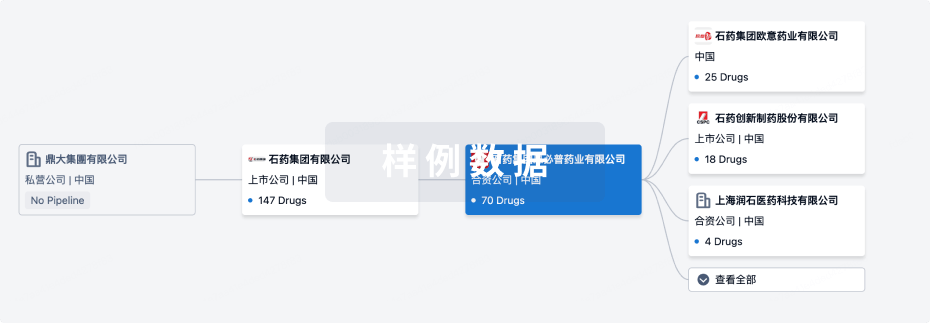
管线布局
2025年09月13日管线快照
管线布局中药物为当前组织机构及其子机构作为药物机构进行统计,早期临床1期并入临床1期,临床1/2期并入临床2期,临床2/3期并入临床3期
药物发现
16
15
临床前
临床申请
1
7
临床申请批准
临床1期
17
4
临床2期
申请上市
2
10
批准上市
其他
23
登录后查看更多信息
药物交易
使用我们的药物交易数据加速您的研究。
登录
或
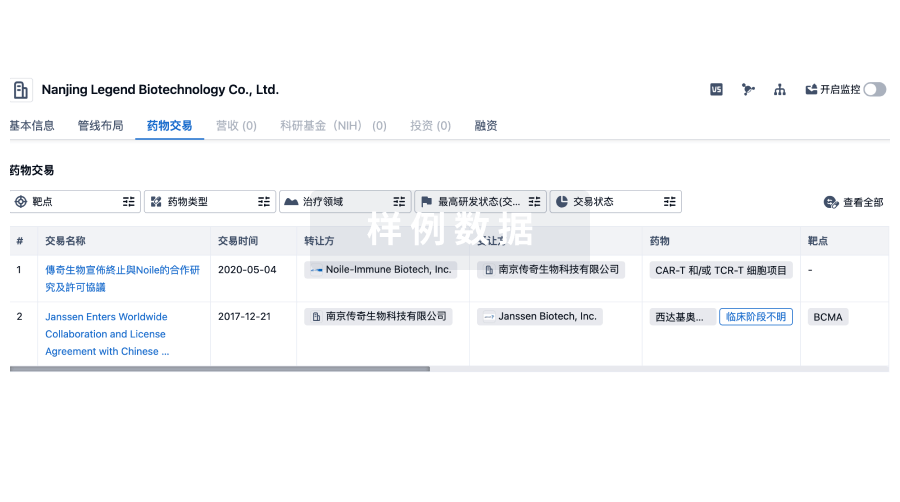
转化医学
使用我们的转化医学数据加速您的研究。
登录
或

营收
使用 Synapse 探索超过 36 万个组织的财务状况。
登录
或
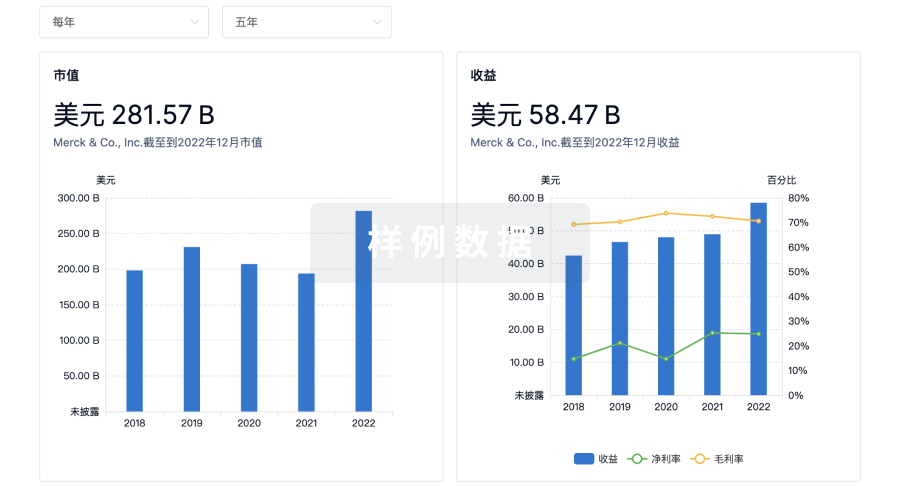
科研基金(NIH)
访问超过 200 万项资助和基金信息,以提升您的研究之旅。
登录
或

投资
深入了解从初创企业到成熟企业的最新公司投资动态。
登录
或
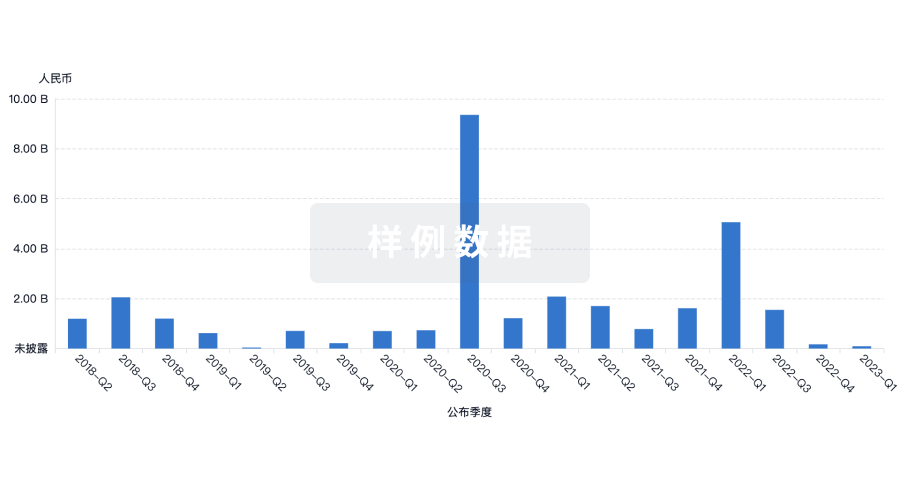
融资
发掘融资趋势以验证和推进您的投资机会。
登录
或
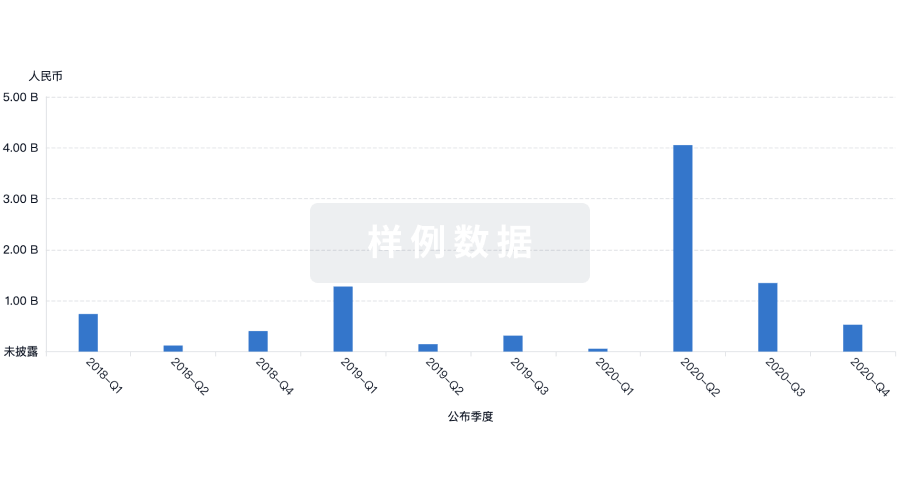
Eureka LS:
全新生物医药AI Agent 覆盖科研全链路,让突破性发现快人一步
立即开始免费试用!
智慧芽新药情报库是智慧芽专为生命科学人士构建的基于AI的创新药情报平台,助您全方位提升您的研发与决策效率。
立即开始数据试用!
智慧芽新药库数据也通过智慧芽数据服务平台,以API或者数据包形式对外开放,助您更加充分利用智慧芽新药情报信息。
生物序列数据库
生物药研发创新
免费使用
化学结构数据库
小分子化药研发创新
免费使用




